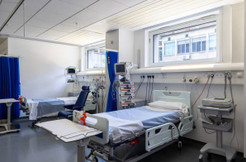Hospitals are, at their core, facilities that help people return to wellness. However, surgery, therapy, treatment, medication, and any of the other classic hospital services are not the only factors that contribute to good health. Designers and architects actually begin planning for wellness before breaking ground on facility construction. There are numerous techniques, materials, and design principles that can help contribute to positive patient outcomes.
Keep reading as we explore some of the best ways to execute hygiene-focused hospital construction.
Secure Space for Ongoing Projects
Hospitals are sprawling facilities that may take many years to complete. In some cases, the hospital will open incrementally as some areas of the building are ready for business well ahead of others.
When this is the case, be sure to implement adequate safeguards to keep patients and visitors out of ongoing construction areas. Use temporary wall panels to create physical barriers that prevent access to secure work areas. Install clear and durable signs to guide traffic safely along designated routes. Implement the best construction dust control systems to ensure that potential airborne toxins from the work site do not make their way into patient areas.
Natural Daylighting
Although Thomas Edison changed the world with the introduction of the lightbulb, studies have shown that too much artificial light can have some negative health effects. Among the most common include:
- Disruption of circadian rhythms for poor sleep quality
- Blurred vision
- Headaches
- Increased stress and anxiety
As such, it is important for architects to design hospitals to promote the natural flow of daylight. Increased window area is one of the best ways to accomplish this. Just be sure to provide adequate treatments in patient rooms for optimal control of light. It is also a great idea to use the open concept in all common areas. Fewer walls will allow light to move freely through the space with less need to use electricity to light each separate area of the facility.
Air Quality Controls
The COVID-19 pandemic gave the world a stark reality check on the importance of air quality controls in commercial spaces. This is underscored in hospitals, where a large percentage of building occupants will have varying levels of compromised immune systems.
With this in mind, there are numerous ways to construct hospitals with air quality in mind. Use air scrubbers and backdraft dampers in HVAC ducts to reduce the threat of toxins traveling through the central air infrastructure. Orient the building with passive ventilation in mind. Install architectural louvers to introduce fresh air into the lobby on warmer days, with wall mounted ceiling fans in lobbies and common areas to keep this fresh air moving. Add easy-to-open windows in patient rooms so they can quickly get some fresh air if their quarters become stuffy.
Low Maintenance Features
Cleaning, sanitation, and sterilization are some of the top priorities in day-to-day hospital operations. Not only do they help prevent the spread of infections, but they create a clean, professional aspect that gives patients and their families confidence that they are in the right environment to promote recovery.
Therefore, because cleaning tasks will occur multiple times a day, it is crucial to choose durable, easy-to-clean materials that promote a sterile environment. Epoxy terrazzo and polished concrete floors hold up incredibly well in the face of heavy foot traffic and moving hospital beds. They are impervious to moisture and can be cleaned with a quick wipe of the mop. Stainless steel commercial railings for staircases and elevated walkways will not absorb hand oils and can be effectively cleaned with a sanitizing wipe without the need for ongoing sealing. Nonporous solid surface countertops guarantee that bacteria never forms due to food and beverage stains.
Functional Exterior Space
Being connected to nature is known for its positive health benefits. In addition to breathing in pure air, being outdoors has some strong benefits in improving mood and reducing anxiety. Build a park next to the hospital campus so that patients can enjoy an open-air walk. In downtown facilities, a courtyard between buildings is a great way to add some exterior space when square footage is limited. Consider a rooftop deck to give patients and their guests the chance to enjoy some views while indulging in an outdoor meal.
Noise Mitigation
Getting peaceful rest is one of the most important components of recovery. Without the proper design, however, the normal bustle of hospital activity can create a noisy atmosphere that makes this difficult to achieve. The good news is that there are numerous noise-mitigating materials that can help promote a tranquil hospital environment.
Insulated concrete forms (ICF) framing creates a robust wall infrastructure to help limit noise pollution from exterior sources. Sound attenuators and hvac silencers can help stifle loud utility rooms. Acoustic wall panels and ceiling clouds add all-important soundproofing mass to the hospital’s interior, helping keep noise local to its origin.
Improve Patient Outcomes With Wellness-Focused Hospital Construction
Patient wellness begins with the architectural blueprints for the hospital facility. From security in the face of ongoing construction to enhanced noise mitigation features, consider any of the ideas listed above for the most hygienic hospital construction possible. For more of the latest trends shaping the healthcare industry, explore the resources at Omnimed for ideas and inspiration today!
Author Bio:
Todd Gillman is a freelance writer that loves sharing his knowledge and expertise on residential and commercial real estate. He lives in Land O’ Lakes, Florida where he enjoys spending time with his wife and researching real estate trends in his free time. Todd’s work as a freelance writer can be found on Building Product Advisor, a construction industry resource site.

